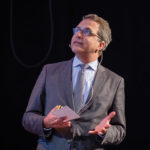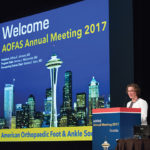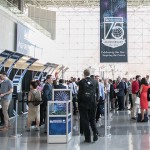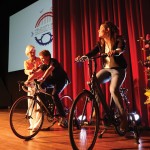
Themed “From Heartfelt Leadership to Compassionate Care,” this 93rd iteration of AOTA’s meeting offered nearly 300 breakout sessions covering all aspects of occupational therapy for attendees of varying experience levels. The conference also included approximately 600 posters spread over seven poster sessions — with topics like “Use of Video-Based Modeling for Children With Autism” and “Occupational Therapy’s Role With Human Trafficking Victims.”
CHALLENGES
Frank Gainer, AOTA’s director of conferences, was unsure whether the location of the meeting would have a negative impact on attendance. The association’s past several meetings had been in the Midwest or on the East Coast, and while there had been growth in attendance numbers, there was concern that a West Coast meeting would pose an accessibility challenge for some members. Luckily, “This was our third-largest conference ever,” Gainer said, with more than 7,400 occupational therapists in attendance — about 1,000 more than attended the 2012 meeting. Gainer had predicted a decrease of about the same number pre-conference.
The numbers that didn’t add up quite as expected were in international attendance, which organizers thought might be boosted by the show’s closer-than-usual proximity to Asia. While there may have been a slight increase in international attendees, “it was only small numbers,” Gainer said. “All the other occupational-therapy associations of the world have their own annual conference.”
INITIATIVES
AOTA derives a large number of its session topics from submitted ideas — beyond those presentations, it only invites about 60 to 70 speakers each year. Because the profession will celebrate its centennial anniversary in 2017, Gainer found that many of this year’s proposed sessions included references to a “Centennial Vision.” “[The presenters] know the buzzwords,” he said. AOTA will start to actively reach out to centennial-focused speakers for the next two Annual Conferences: 2014 in Baltimore and 2015 in Nashville.
In response to previous post-conference surveys, AOTA implemented more sessions for advanced-level practitioners this year. These three-hour programs included “something with a reflective component in it,” Gainer said, “so participants have an opportunity to talk to each other.”
Tech Day, a historically popular element of the Annual Conference, was once again a hit with attendees. AOTA worked with a new audiovisual company — BAV — that helped to incorporate more hands-on elements into workstations showcasing both high- and low-tech adaptive devices that therapists can use with patients. BAV’s improvements affected the entire experience, according to Gainer. “Just the whole way the room was laid out — the signage was better, it had a better flow,” he said. “We were able to offer a lot more opportunities for both speakers and members in Tech Day as far as the AV support.”
Convene’s Pre-Con/Post-Con series asks meeting planners about their challenges and how they intend to address them (Pre-Con), and then checks back in after the meeting has occurred (Post-Con) to see how well they worked out.



